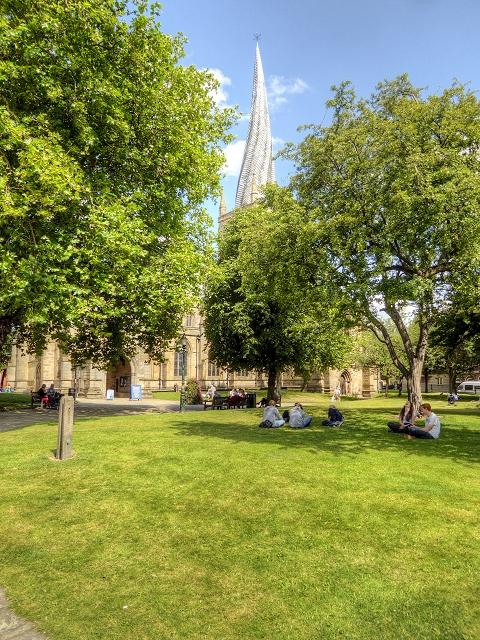Ss Augustine
Chesterfield , Derbyshire
A parish church that serves the complex needs of its local community.

The 'Crooked Spire' is one of Derbyshire's best known landmarks, it's 228 feet high and leans 9 feet 6 inches from its true centre.
Chesterfield, Derbyshire
But even knowing all this doesn't prepare you for walking down High Street and finding yourself in its shadow. The hardest thing to deal with, though, is seeing all those shoppers cheerfully walking about without even noticing it! The Spire has been crooked for so long that local people don't spare it a thought any longer, but it stands on the skyline like a question mark.
There are spires in Europe which were deliberately built with a twist, but Chesterfield's Spire started its life straight. History is silent about when it began to lean. We do know that it's still moving but, don't worry, it's not about to fall down, even though the only thing that holds the spire on top of the tower is its own weight, around 150 tons of wood and more than 30 tons of lead!
Legend tells of a powerful and evil wizard who tricked the Bolsover blacksmith into shoeing the Devil. Shaking in terror, the poor man drove a nail into the Devil's foot. Screaming with rage and pain, the Devil took flight towards Chesterfield. Skimming over the church, he lashed out in agony, caught the spire and twisted it out of shape.
A more plausible reason for the distortion is the 32 tonnes of lead covering the wood shingles some years after initial construction. These lead tiles created such a heavy weight that the timbers simply couldn't bear the strain, and, with no cross races for support, twisted alarmingly.
St Mary & All Saints is so big that it's often mistaken for a cathedral and, in fact, it’s the largest church in Derbyshire. The old market place was much closer to the church in the Middle Ages, and it wasn't unusual for the nave to be used as a temporary store. This is why, in May 1266, at the height of the Battle of Chesterfield, we find the Earl of Derby hiding among the wool sacks in the church. Sadly for the Earl, he was found and sent to London to face King Henry III.
The church survived the Battle of Chesterfield and, later, the Civil War and the bombing raids of World War II, but it faced its greatest danger at 9am on 22 December 1961. Fire broke out in the north transept and flames roared through the building to threaten the Spire itself. Within minutes the roads were packed with fire engines and equipment. Church officials and clergy braved the heat and choking smoke to rescue sacred figurines, church treasures and parish registers from the flames. The blaze was finally stopped in the tower.
Chesterfield , Derbyshire
A parish church that serves the complex needs of its local community.
Calow, Derbyshire
Old Whittington, Derbyshire
The first church on this site was erected in 1140.